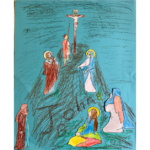
The life of St. Thomas Aquinas takes us back to the Middle Ages when villages grew around castles and monasteries were centres of learning.
Thomas was born in 1225 in a castle in Roccasecca in the region today known as Lazio, Italy. His father was Count Landulf of Aquino, his mother was Countess Theodora of Teano. He came from a large family of 3 brothers and 5 sisters. Thomas spent his childhood, between 5 and 13 years old in Monte Cassino, a famous monastery of those days, where his uncle was the Benedictine Abbot (Superior), to receive his first education. His parents were hoping that Thomas would himself become Abbot, a very prestigious position of nobility in those days. But when he was 14 years old, because of military and political conflicts, Thomas had to leave Monte Cassino and went to continue his studies in the University of Naples that had just been established.
As a young man Thomas had grown into a tall man of ‘ a bulky figure’, unusually quiet, but already proving to be a brilliant scholar, a genius of rare wisdom and described as ‘refined, affable and lovable’. It is said that he was often referred to as ‘dumb ox’ not because his peers thought he was not intelligent, but because he did not talk much. He was in fact listening, thinking, reflecting.
Probably it was during his University studies that he became interested in the Greek philosopher Aristotle, whose philosophical principles intrigued Thomas. It was also at this University that he came in contact with the Dominicans, a poor mendicant Order of preachers that had just been founded by Dominic of Gusman, later St.Dominic.
Thomas was 19 years old when his father died. At the same time, he had reached a decision to join the Domincans. Thomas’ family was furious since their plan for him was to join the Benedictine Order that was more befitting the status of nobility. Thomas was abducted by his family and was kept locked in a family castle for over a year. During this time while all the members of his family tried to convince him to change his mind, he continued with his Scripture studies continuing to keep contact with the Dominicans in one way or another. Eventually, his mother allowed him to escape during the night! Thomas rejoined the Dominicans and was ordained priest in 1250. He travelled to Paris where he continued his studies under Albert the Great, excelling in all areas of study. When he was 26 years old, the Pope conferred on him the title ‘Master of Theology.’
Thomas spent the rest of his life producing commentaries on Scripture, writing sermons and books, besides a number of liturgical hymns. At the same time, he continued to teach and preach, combatting controversies in debates defending the Catholic Faith, travelling to Paris, Naples, Orvieto and Rome as the Papal Theologian.
St. Thomas Aquinas continues to be renowned for his Summa Theologea/ Summary of Theology, a masterpiece in philosophy and theology which he never completed.
Besides being one of the Doctors of the Church St. Thomas is also known as ‘The Angelic Doctor’ perhaps because he wrote extensively on the theology of Angels but more so because he has been described as ‘the teacher who is like an angel’ ‘pure, strong, close to God and truly a messenger of divine light’.
The greatness of St. Thomas lies not only in his brilliant intellect but also because he could understand complicated truths of the Faith and then express them in ways that could be ‘grasped.’
He died when he was barely 50 years old on his way to the Council of Lyons, leaving a legacy of philosophical and theological arguments that ‘Faith and Reason could work together to support the One Truth in God.’













